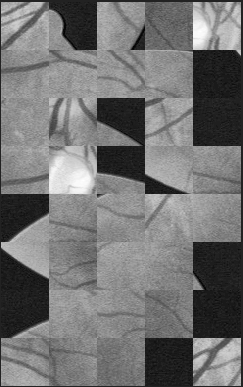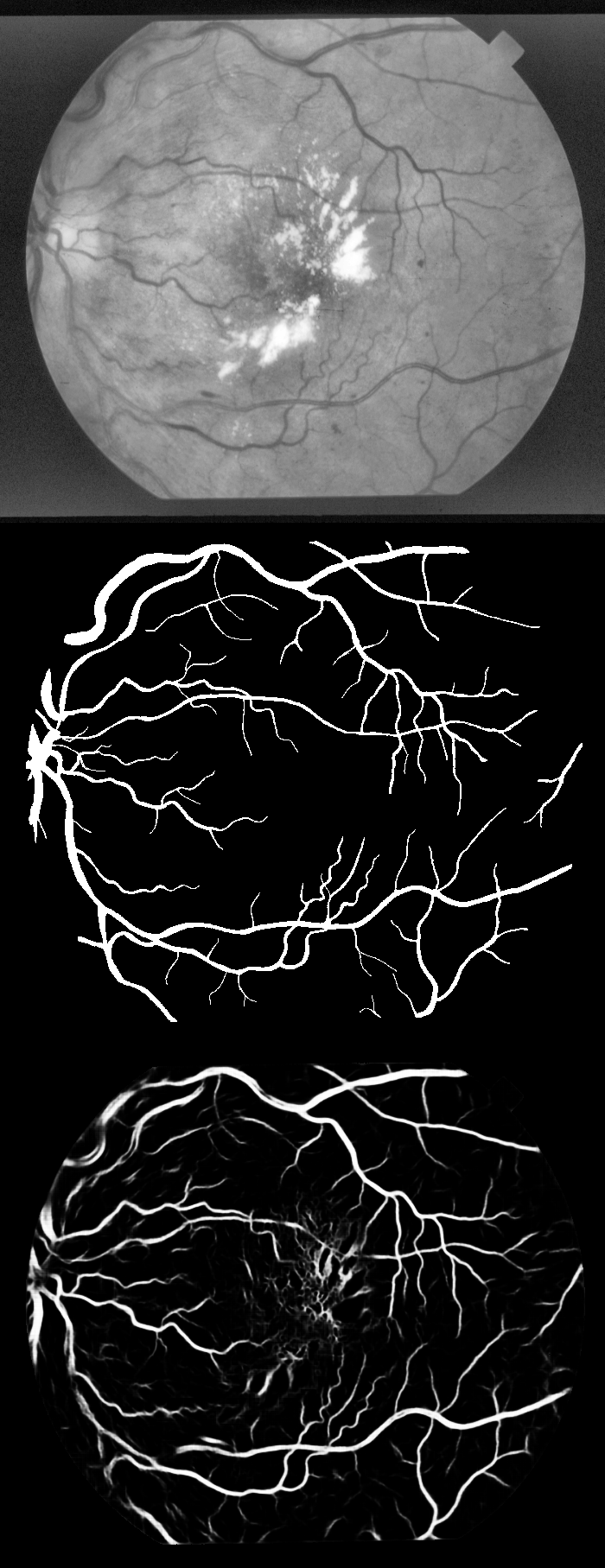Unet 项目部分代码学习
github地址:https://github.com/orobix/retina-unet
主程序:
###################################################
#
# Script to:
# - Load the images and extract the patches
# - Define the neural network
# - define the training
#
################################################## import numpy as np
import configparser as ConfigParser from keras.models import Model
from keras.layers import Input, concatenate, Conv2D, MaxPooling2D, UpSampling2D, Reshape, core, Dropout
from keras.optimizers import Adam
from keras.callbacks import ModelCheckpoint, LearningRateScheduler
from keras import backend as K
from keras.utils.vis_utils import plot_model as plot
from keras.optimizers import SGD import sys
sys.path.insert(0, './lib/')
from help_functions import * #function to obtain data for training/testing (validation)
from extract_patches import get_data_training #Define the neural network
def get_unet(n_ch,patch_height,patch_width):
inputs = Input(shape=(n_ch,patch_height,patch_width))
conv1 = Conv2D(32, (3, 3), activation='relu', padding='same',data_format='channels_first')(inputs)
conv1 = Dropout(0.2)(conv1)
conv1 = Conv2D(32, (3, 3), activation='relu', padding='same',data_format='channels_first')(conv1)
pool1 = MaxPooling2D((2, 2))(conv1)
#
conv2 = Conv2D(64, (3, 3), activation='relu', padding='same',data_format='channels_first')(pool1)
conv2 = Dropout(0.2)(conv2)
conv2 = Conv2D(64, (3, 3), activation='relu', padding='same',data_format='channels_first')(conv2)
pool2 = MaxPooling2D((2, 2))(conv2)
#
conv3 = Conv2D(128, (3, 3), activation='relu', padding='same',data_format='channels_first')(pool2)
conv3 = Dropout(0.2)(conv3)
conv3 = Conv2D(128, (3, 3), activation='relu', padding='same',data_format='channels_first')(conv3) up1 = UpSampling2D(size=(2, 2))(conv3)
up1 = concatenate([conv2,up1],axis=1)
conv4 = Conv2D(64, (3, 3), activation='relu', padding='same',data_format='channels_first')(up1)
conv4 = Dropout(0.2)(conv4)
conv4 = Conv2D(64, (3, 3), activation='relu', padding='same',data_format='channels_first')(conv4)
#
up2 = UpSampling2D(size=(2, 2))(conv4)
up2 = concatenate([conv1,up2], axis=1)
conv5 = Conv2D(32, (3, 3), activation='relu', padding='same',data_format='channels_first')(up2)
conv5 = Dropout(0.2)(conv5)
conv5 = Conv2D(32, (3, 3), activation='relu', padding='same',data_format='channels_first')(conv5)
#
conv6 = Conv2D(2, (1, 1), activation='relu',padding='same',data_format='channels_first')(conv5)
conv6 = core.Reshape((2,patch_height*patch_width))(conv6)
conv6 = core.Permute((2,1))(conv6)
############
conv7 = core.Activation('softmax')(conv6) model = Model(inputs=inputs, outputs=conv7) # sgd = SGD(lr=0.01, decay=1e-6, momentum=0.3, nesterov=False)
model.compile(optimizer='sgd', loss='categorical_crossentropy',metrics=['accuracy']) return model #Define the neural network gnet
#you need change function call "get_unet" to "get_gnet" in line 166 before use this network
def get_gnet(n_ch,patch_height,patch_width):
inputs = Input((n_ch, patch_height, patch_width))
conv1 = Convolution2D(32, 3, 3, activation='relu', border_mode='same')(inputs)
conv1 = Dropout(0.2)(conv1)
conv1 = Convolution2D(32, 3, 3, activation='relu', border_mode='same')(conv1)
up1 = UpSampling2D(size=(2, 2))(conv1)
#
conv2 = Convolution2D(16, 3, 3, activation='relu', border_mode='same')(up1)
conv2 = Dropout(0.2)(conv2)
conv2 = Convolution2D(16, 3, 3, activation='relu', border_mode='same')(conv2)
pool1 = MaxPooling2D(pool_size=(2, 2))(conv2)
#
conv3 = Convolution2D(32, 3, 3, activation='relu', border_mode='same')(pool1)
conv3 = Dropout(0.2)(conv3)
conv3 = Convolution2D(32, 3, 3, activation='relu', border_mode='same')(conv3)
pool2 = MaxPooling2D(pool_size=(2, 2))(conv3)
#
conv4 = Convolution2D(64, 3, 3, activation='relu', border_mode='same')(pool2)
conv4 = Dropout(0.2)(conv4)
conv4 = Convolution2D(64, 3, 3, activation='relu', border_mode='same')(conv4)
pool3 = MaxPooling2D(pool_size=(2, 2))(conv4)
#
conv5 = Convolution2D(128, 3, 3, activation='relu', border_mode='same')(pool3)
conv5 = Dropout(0.2)(conv5)
conv5 = Convolution2D(128, 3, 3, activation='relu', border_mode='same')(conv5)
#
up2 = merge([UpSampling2D(size=(2, 2))(conv5), conv4], mode='concat', concat_axis=1)
conv6 = Convolution2D(64, 3, 3, activation='relu', border_mode='same')(up2)
conv6 = Dropout(0.2)(conv6)
conv6 = Convolution2D(64, 3, 3, activation='relu', border_mode='same')(conv6)
#
up3 = merge([UpSampling2D(size=(2, 2))(conv6), conv3], mode='concat', concat_axis=1)
conv7 = Convolution2D(32, 3, 3, activation='relu', border_mode='same')(up3)
conv7 = Dropout(0.2)(conv7)
conv7 = Convolution2D(32, 3, 3, activation='relu', border_mode='same')(conv7)
#
up4 = merge([UpSampling2D(size=(2, 2))(conv7), conv2], mode='concat', concat_axis=1)
conv8 = Convolution2D(16, 3, 3, activation='relu', border_mode='same')(up4)
conv8 = Dropout(0.2)(conv8)
conv8 = Convolution2D(16, 3, 3, activation='relu', border_mode='same')(conv8)
#
pool4 = MaxPooling2D(pool_size=(2, 2))(conv8)
conv9 = Convolution2D(32, 3, 3, activation='relu', border_mode='same')(pool4)
conv9 = Dropout(0.2)(conv9)
conv9 = Convolution2D(32, 3, 3, activation='relu', border_mode='same')(conv9)
#
conv10 = Convolution2D(2, 1, 1, activation='relu', border_mode='same')(conv9)
conv10 = core.Reshape((2,patch_height*patch_width))(conv10)
conv10 = core.Permute((2,1))(conv10)
############
conv10 = core.Activation('softmax')(conv10) model = Model(input=inputs, output=conv10) # sgd = SGD(lr=0.01, decay=1e-6, momentum=0.3, nesterov=False)
model.compile(optimizer='sgd', loss='categorical_crossentropy',metrics=['accuracy']) return model #========= Load settings from Config file
config = ConfigParser.RawConfigParser()
config.read('configuration.txt')
#patch to the datasets
path_data = config.get('data paths', 'path_local')
#Experiment name
name_experiment = config.get('experiment name', 'name')
#training settings
N_epochs = int(config.get('training settings', 'N_epochs'))
batch_size = int(config.get('training settings', 'batch_size')) #============ Load the data and divided in patches
patches_imgs_train, patches_masks_train = get_data_training(
DRIVE_train_imgs_original = path_data + config.get('data paths', 'train_imgs_original'),
DRIVE_train_groudTruth = path_data + config.get('data paths', 'train_groundTruth'), #masks
patch_height = int(config.get('data attributes', 'patch_height')),
patch_width = int(config.get('data attributes', 'patch_width')),
N_subimgs = int(config.get('training settings', 'N_subimgs')),
inside_FOV = config.getboolean('training settings', 'inside_FOV') #select the patches only inside the FOV (default == True)
) #========= Save a sample of what you're feeding to the neural network ==========
N_sample = min(patches_imgs_train.shape[0],40)#这里规定,要显示的图片最多不超过40张
visualize(group_images(patches_imgs_train[0:N_sample,:,:,:],5),'./'+name_experiment+'/'+"sample_input_imgs")#.show()
visualize(group_images(patches_masks_train[0:N_sample,:,:,:],5),'./'+name_experiment+'/'+"sample_input_masks")#.show()
#显示的结果会在下面贴出来 #=========== Construct and save the model arcitecture =====
n_ch = patches_imgs_train.shape[1]#得到每个patch的通道数
patch_height = patches_imgs_train.shape[2]#得到每个patch的高
patch_width = patches_imgs_train.shape[3]#得到每个patch的宽
model = get_unet(n_ch, patch_height, patch_width) #the U-net model
print ("Check: final output of the network:")
print (model.output_shape)
plot(model, to_file='./'+name_experiment+'/'+name_experiment + '_model.png') #check how the model looks like
json_string = model.to_json()#model.to_json:返回代表模型的JSON字符串,仅包含网络结构,不包含权值。可以从JSON字符串中重构原模型:
open('./'+name_experiment+'/'+name_experiment +'_architecture.json', 'w').write(json_string) #============ Training ==================================
checkpointer = ModelCheckpoint(filepath='./'+name_experiment+'/'+name_experiment +'_best_weights.h5', verbose=1, monitor='val_loss', mode='auto', save_best_only=True) #save at each epoch if the validation decreased # def step_decay(epoch):
# lrate = 0.01 #the initial learning rate (by default in keras)
# if epoch==100:
# return 0.005
# else:
# return lrate
#
# lrate_drop = LearningRateScheduler(step_decay) patches_masks_train = masks_Unet(patches_masks_train) #reduce memory consumption
model.fit(patches_imgs_train, patches_masks_train, nb_epoch=N_epochs, batch_size=batch_size, verbose=2, shuffle=True, validation_split=0.1, callbacks=[checkpointer]) #========== Save and test the last model ===================
model.save_weights('./'+name_experiment+'/'+name_experiment +'_last_weights.h5', overwrite=True)
#test the model
# score = model.evaluate(patches_imgs_test, masks_Unet(patches_masks_test), verbose=0)
# print('Test score:', score[0])
# print('Test accuracy:', score[1])

实验结果显示:上中下分别为原图-groundTruth-预测图

Unet 项目部分代码学习的更多相关文章
- R2CNN项目部分代码学习
首先放出大佬的项目地址:https://github.com/yangxue0827/R2CNN_FPN_Tensorflow 那么从输入的数据开始吧,输入的数据要求为tfrecord格式的数据集,好 ...
- FCN 项目部分代码学习
下面代码由搭档注释,保存下来用作参考. github项目地址:https://github.com/shekkizh/FCN.tensorflowfrom __future__ import prin ...
- CTPN项目部分代码学习
上次拜读了CTPN论文,趁热打铁,今天就从网上找到CTPN 的tensorflow代码实现一下,这里放出大佬的github项目地址:https://github.com/eragonruan/text ...
- JAVAEE——BOS物流项目02:学习计划、动态添加选项卡、ztree、项目底层代码构建
1 学习计划 1.jQuery easyUI中动态添加选项卡 2.jquery ztree插件使用 n 下载ztree n 基于标准json数据构造ztree n 基于简单json数据构造ztree( ...
- Android开源项目SlidingMenu本学习笔记(两)
我们已经出台SlidingMenu使用:Android开源项目SlidingMenu本学习笔记(一个),接下来再深入学习下.依据滑出项的Menu切换到相应的页面 文件夹结构: watermark/2/ ...
- IDEA 学习笔记之 Java项目开发深入学习(1)
Java项目开发深入学习(1): 定义编译输出路径: 继承以上工程配置 重新定义新的项目编译路径 添加source目录:点击添加,再点击移除: 编译项目: 常用快捷键总结: Ctrl+Space 代码 ...
- 201671010447 杨露露 实验十四 团队项目评审&课程学习总结
项目 内容 这个作业属于哪个课程 2016计算机科学与工程学院软件工程(西北师范大学) 这个作业的要求在哪里 实验十四 团队项目评审&课程学习总结 作业学习目标 总结这学期软件工程学习获得 一 ...
- 实验十四 团队项目评审&课程学习总结
项目 内容 这个作业属于哪个课程 2016计算机科学与工程学院软件工程(西北师范大学) 这个作业的要求在哪里 实验十四 团队项目评审&课程学习总结 团队名称 快活帮 作业学习目标 (1)掌握软 ...
- 201671010449 杨天超 实验十四 团队项目评审&课程学习总结
项目 内容 这个作业属于哪个课程 任课教师博客主页链接 这个作业的要求在哪里 作业链接地址 作业学习目标 1.掌握软件评审流程及内容 2.个人总结 实验一问题解答 实验一问题链接:https://ww ...
随机推荐
- TensorFlow学习笔记之--[tf.app.flags使用方法]
很多时候在运行python代码的时候我们需要从外部定义参数,从而避免每次都需要改动代码.所以一般我们都会使用 argparse 这个库.其实TensorFlow也提供了这个功能,那就是 tf.app. ...
- Android AlertDialog 绝对位置计算
public class Main2Activity extends AppCompatActivity { @Override protected void onCreate(Bundle save ...
- inception v1-v3 & Xception
inception v1-v3:通过多尺度卷积核学习不同尺度的空间信息并进行耦合:通过多个小卷积核来代替大卷积核的功能从而降低计算量: 通常,在一组特征图上进行卷积需要三维的卷积核,也即卷积核需要同时 ...
- python中的正则表达式--re模块
参考博客:https://www.cnblogs.com/tina-python/p/5508402.html 这里说一下python的re模块即正则表达式模块,先列出其中涉及到的各种字符和模式等: ...
- LwIP Application Developers Manual5---高层协议之DNS
1.前言 lwIP提供一个基本的DNS客户端(1.3.0后引进),通过使用DNS(Domain Name System)协议来允许应用程序解决主机名到地址的转换. 在文件lwipopts.h里面定义L ...
- Unity3D游戏开发框架-资源管理类ResourceManage
新建文件夹:ResMgr.接着新建三个C#脚本.代码如下: IResLoadListener.cs AssetInfo.cs ResMgr.cs using UnityEngine; using Sy ...
- ES--03
第二十一讲! 1.上机动手实战演练基于_version进行乐观锁并发控制 (1)先构造一条数据出来 PUT /test_index/test_type/7{ "test_field" ...
- maven项目导入war包
导入war包,使用war包中的类和静态资源(css,js,包含jsp等) A项目是被导入的war工程,B项目是需要A项目的一个工程. 在<build>中 <resources> ...
- python实现求最大公约数与最小公倍数
记录python实现最大公约数&最小公位数两种算法 概念 最大公约数:指两个或多个整数共有约数中最大的一个 最小公倍数:两个或多个整数公有的倍数叫做它们的公倍数,其中除0以外最小的一个公倍数就 ...
- 18)django-模板的过滤器和tag,自定义simple_tag和filter
模板过滤器是在变量被显示前修改它的值的一个简单方法. 过滤器使用管道字符 . 模板标签(template tag) .标签(tag)定义比较明确,即: 仅通知模板系统完成某些工作的标签. 一:dja ...
